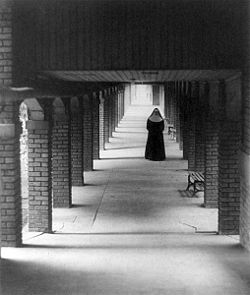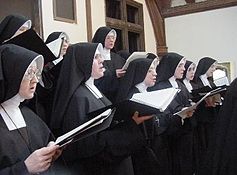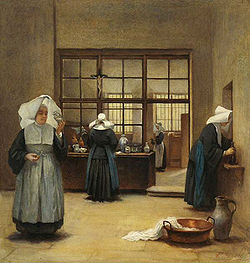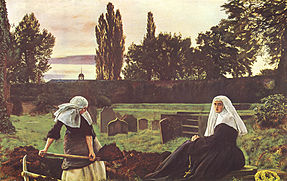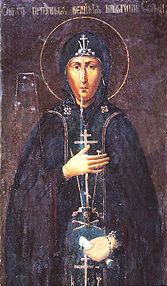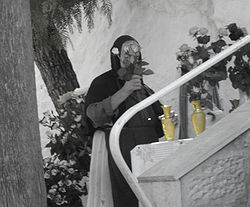- Nun
-
For other uses, see Nun (disambiguation).
A nun is a woman who has taken vows committing her to live a spiritual life.[1] She may be an ascetic who voluntarily chooses to leave mainstream society and live her life in prayer and contemplation in a monastery or convent. The term "nun" is applicable to Catholics – both eastern and western traditions – Orthodox Christians, Anglicans, Lutherans, Jains, Buddhists, Taoists, and Hindus. While in common usage the terms nun and sister are often used interchangeably, in some cases they are differentiated, a nun being a religious woman who lives a contemplative cloistered life of prayer and meditation, while a sister, in Christian denominations, lives an active vocation of prayer and service, often to the needy, sick, poor, and uneducated.
Contents
Buddhism
Main article: BhikkhuniPeople of the Pali Canon
Pali English Monastic Sangha Laity Upāsaka and Upāsikā
Gahattha, Gahapati
Agārika, AgāriyaLay devotee (m., f.)
Householder
LaypersonRelated Religions
All Buddhist traditions have nuns, although their status is different among the various Buddhist countries. The Buddha is reported to have allowed women into the sangha only with great reluctance, predicting that the move would lead to Buddhism's collapse after 500 years, rather than the 1,000 years it would have enjoyed otherwise (this prophecy occurs only once in the Canon and is the only prophecy involving time in the Canon, leading some to suspect that it is a late addition.)[2] Fully ordained Buddhist nuns (bhikkhunis) have more Patimokkha-rules than the monks (bhikkhus). The important vows are the same, however.
As with monks, there is quite a lot of variation in nuns' dress and social conventions between different Buddhist cultures in Asia. Chinese nuns possess the full bhikkuni ordination, Tibetan nuns do not, and in Theravada countries female renunciates are discouraged from even wearing saffron robes. Disparities may often be observed in the amount of respect and financial resources given to monks viz. Nuns, with nuns receiving less of both in all countries with the possible exception of Taiwan. Despite barriers, some nuns succeed in becoming religious teachers and authorities.
Thailand
 Buddhist nuns in Rangoon, Burma.
Buddhist nuns in Rangoon, Burma.
In Thailand, a country which never had a tradition of fully ordained nuns (bhikkhuni), there developed a separate order of non-ordained female renunciates called mae ji. However, some of them has played an important role in dharma-practitioners' community. There are in Thai Forest Tradition foremost nuns such as Mae Ji Kaew Sianglam, the founder of Nunnery of Baan Huai Saai, who is believed to be enlightened[3] as well as Upāsikā Kee Nanayon.[4] At the beginning of the 21st century, some Buddhist women in Thailand have started to introduce the bhikkhuni sangha in their country as well, even if public acceptance is still lacking.[5] Dhammananda Bhikkhuni,[6] formerly the successful academic scholar Dr. Chatsumarn Kabilsingh, established a controversial monastery for the training of Buddhist nuns in Thailand.[7]
Taiwan
Chinese Buddhism possesses a full bhikkuni tradition. Thanks largely to the efforts of Master Cheng Yen of the Buddhist charity Tzu Chi (which utterly dominates philanthopic giving in Taiwan), Taiwan's nuns nowadays probably receive more public respect and support than monks.
Researcher Charles Brewer Jones estimates that since 1952, when the Buddhist Association of the ROC organized public ordination, female applicants have outnumbered males by about three to one. He adds:
- "All my informants in the areas of Taipei and Sanhsia considered nuns at least as respectable as monks, or even more so. [...] In contrast, however, Shiu-kuen Tsung found in Taipei county that female clergy were viewed with some suspicion by society. She reports that while outsiders did not necessarily regard their vocation as unworthy of respect, they still tended to view the nuns as social misfits."[8]
Tibet
The August 2007 International Congress on Buddhist Women's Role in the Sangha, with the support of H. H. XIVth Dalai Lama, reinstated the Gelongma (Dharmaguptaka vinaya bhikkhuni) lineage, having been lost, in India and Tibet, for centuries. Gelongma ordination requires the presence of ten fully ordained people keeping exactly the same vows. Because ten nuns are required in order to ordain a new one, the effort to establish the Dharmaguptaka bhikkhu tradition has taken a long time.
It is permissible for a Tibetan nun to receive bhikkhuni ordination from another living tradition, e.g. in Vietnam. Based on this, Western nuns ordained in Tibetan tradition, like Thubten Chodron, took full ordination in another tradition.
The ordination of monks and nuns in Tibetan Buddhism distinguishes three stages rabjung-ma, getshül-ma and gelong-ma. The clothes of the nuns in Tibet are basically the same as those of monks, but there are differences between novice and gelong robes.
Christianity
Catholic
 A Catholic Sister in brightly coloured clothes rides a motor-bike, Basankusu, Democratic Republic of Congo.
A Catholic Sister in brightly coloured clothes rides a motor-bike, Basankusu, Democratic Republic of Congo.
In the Catholic Church, a nun is a woman who has taken solemn vows (the male equivalent is often called a monk or friar, although the positions actually entail very different duties of the church).[citation needed] The main distinction between a nun and a sister is that nuns have solemn vows and sisters have simple vows, which allows them to inherit property, unlike a nun. Also, as monastics, nuns commit themselves to the daily recitation of the Liturgy of the Hours throughout the day in church, usually in a solemn manner. Thus, for those making this commitment, they are distinguished within the monastic community under the title of choir nuns, as opposed to "lay Sisters", who are entrusted with the upkeep of the monastery, or even running errands outside the cloister.
Nuns are usually cloistered or enclosed to the degree established by the rule of the religious institution they enter;[9] exceptions include one branch of Visitandines and the Ursulines. This is another distinction from Religious Sisters, as these are usually involved in some form of apostolic work or ministry, traditionally that of nursing or teaching, which requires them to be out among the public.
In the Roman Catholic tradition, there are a large number of different orders of nuns and Sisters, each with its own charism or special character.
In general, when a woman enters a convent, monastery or abbey, she first undergoes an initial period of testing the life for a period of six months to a year called a postulancy. If she, and the order, determine that she may have a vocation to the life, she receives the habit of the order (usually with some modification,normally a white veil instead of a black, to distinguish her from professed nuns) and undertakes the novitiate, a period (that lasts one to two years) of living the life of a nun without yet taking vows.[10] Upon completion of this period she may take her initial, temporary vows.[11] Temporary vows last one to three years, typically, and will be professed for not less than three years and not more than six.[12] Finally, she will petition to make her "perpetual profession", taking permanent, solemn vows.[13]
In the various branches of the Benedictine tradition (Benedictines, Cistercians, Camaldolese, and Trappists among others) nuns take vows of stability (that is, to remain a member of a single monastic community), obedience (to an abbess or prioress), and "conversion of life" (which includes poverty and chastity). The "Poor Clares" (a Franciscan order) and those Dominican nuns who live a cloistered life take the threefold vows of poverty, chastity and obedience. Most orders of nuns not listed here follow one of these two patterns, with some orders taking an additional vow related to the specific work or character of their order (for example, to undertake a certain style of devotion, praying for a specific intention or purpose).
Cloistered nuns (Carmelites, for example) observe "papal enclosure" [14] rules and their monasteries typically have walls separating the nuns from the outside world. The nuns rarely leave (except for medical necessity, or occasionally for purposes related to their contemplative life) though they may have visitors in specially built parlors, often with either a "grill" or half-wall separating the nuns' side from the visitors', that allow them to meet with outsiders. They are usually self-sufficient, earning money by selling jams or candies or baked goods by mail order, or by making liturgical items (such as vestments, candles, or hosts to be Consecrated at Mass for Holy Communion).
They often undertake contemplative ministries—that is, a monastery of nuns is often associated with prayer for some particular good or supporting the missions of another Order by prayer (for instance, the Dominican nuns of Corpus Christi Monastery in the Bronx, N.Y. pray in support of the priests of the Archdiocese of New York. Yet Religious Sisters can also do this form of ministry, e.g., the Maryknoll Missionary Sisters have small houses of contemplative Sisters, some in mission locations, who pray for the work of the priests, brothers and other Sisters of their Congregation; the Sister Disciples of the Divine Master are also cloistered Sisters who pray in support of their sister congregation, the Daughters of St. Paul in their media ministry.
A canoness is a nun who corresponds to the male equivalent, a canon. The origin and rules of monastic life are common to both. As with the canons, differences in the observance of rule gave rise to two types: the canoness regular, who lives in a religious house, taking the traditional religious vows, and the secular canoness, which was primarily a way of leading a pious life by daughters of aristocratic families who did not wish to take religious vows, and thus remained free to own property and leave to marry, should they choose. This latter way of life has disappeared in the modern age.
A nun who is elected to head her religious house is termed an abbess if the house is an abbey, with the exception of Poor Clares who have an abbess but no abbey perhaps from St. Clare's beginning her religious life "train" by the Benedictines, to whom St. Francis entrusted her, who have abbesses, a prioress if it is a monastery, or more generically may be referred to as the Mother Superior and styled "Reverend Mother". The distinction between abbey and monastery has to do with the terms used by a particular order or by the level of independence of the religious house. Technically, a convent is any home of a community of sisters—or, indeed, of priests and brothers, though this term is rarely used in the U.S. The term "monastery" is often used by communities within the Benedictine family, and "convent" (when referring to a cloister) is often used of the monasteries of certain other orders.
Traditional cloistered nuns' clothing consists of a tunic which is tied around the waist with a cloth or leather belt. Over the tunic some nuns wear a scapular which is a garment of long wide piece of woolen cloth worn over the shoulders with an opening for the head. Some wear a white wimple which "encircles" the face and a veil the most significant and ancient aspect of the habit. Some nuns such as Poor Clares wear a large rosary on their belt. Benedictine Abbesses wear a cross or crucifix on a chain around their neck. After the second Vatican Council, many orders chose to no longer wear the traditional habit, and as well did away with choosing a religious name. However, Catholic Church or Canon Law states (669.1) "As a sign of their consecration and as a witness to poverty religious are to wear their habit in accordance with the institute's own law."
Distinction between a nun and a religious sister
During the first millennium, nearly all communities of men and women were dedicated to prayer and contemplation. These monasteries, abbeys, or convents were built in remote locations or were separated from the world by means of a cloister. The mendicant orders, founded in the 13th century, combined a life of prayer and dedication to God with active works of preaching, hearing confessions, and service to the poor, and members of these orders are known as friars rather than monks. At that time, Church law did not allow women to leave the cloister if they had taken religious vows. Female members of the mendicant orders (Dominican, Augustinian and Carmelite nuns and Poor Clares) continued to observe the same enclosed life as members of the monastic orders.
Originally, the vows taken by profession in any religious institute approved by the Holy See were classified as solemn.[15] This was declared by Pope Boniface VIII (1235–1303).[16] The situation changed in the 16th century. In 1521, two years after the Fourth Lateran Council had forbidden the establishment of new religious institutes, Pope Leo X appointed a religious rule with simple vows for those tertiaries attached to existing institutes who undertook to live in a community. In 1566 and 1568, Pope Pius V rejected this class of congregation, but they continued to exist and even increased in number. After at first being merely tolerated, they afterwards obtained approval.[15] Pope Leo XIII recognized as religious all men and women who took simple vows.[17] Their lives were oriented not to the ancient monastic way of life, but more to social service and to evangelization, both in Europe and in mission areas. Their number increased further in the upheavals brought by the French Revolution and subsequent Napoleonic invasions of other Catholic countries, depriving thousands of religious of the income that their communities held because of inheritances and forcing them to find a new way of living the religious life. But members of these new associations were not recognized as "religious" until Pope Leo XIII's Constitution "Conditae a Christo" of 8 December 1900.[18]
The 1917 Code of Canon Law reserved the term "nun" (Latin: monialis) for women religious who took solemn vows or who, while being allowed in some places to take simple vows, belonged to institutes whose vows were normally solemn.[19] It used the word "sister" (Latin: soror) exclusively for members of institutes for women that it classified as "congregations"; and for "nuns" and "sisters" jointly it used the Latin word religiosae (women religious). The same religious order could include both "nuns" and "sisters", if some members took solemn vows and other simple vows.
The current Code of Canon Law has dropped those distinctions, but some continue to apply them as if still in force. However, in popular speech, the terms "nun" and "sister" are used interchangeably for any woman religious.
Eastern Orthodox
Main article: Eastern Christian MonasticismIn the Eastern Orthodox Church there is no distinction between a monastery for women and a monastery for men. In Greek, Russian, and other Eastern European languages, both domiciles are called "monasteries" and the ascetics who live therein are "Monastics". In English, however, it is acceptable to use the terms "nun" and "convent" for clarity and convenience. The term for an abbess is the feminine form of abbot (hegumen)—Greek: hegumeni; Serbian: Игуманија (Igumanija); Russian: игумения, (igumenia). Orthodox monastics do not have distinct "orders" as in Western Christianity. Orthodox monks and nuns lead identical spiritual lives.[20] There may be slight differences in the way a monastery functions internally but these are simply differences in style (Gr. typica) dependent on the Abbess or Abbot. The Abbess is the spiritual leader of the convent and her authority is absolute (no priest, bishop, or even patriarch can override an abbess within the walls of her monastery.) There has always been spiritual equality between men and women in the Orthodox Church (Galatians 3:28). Abbots and Abbesses rank in authority equal to bishops in many ways and were included in ecumenical councils. Orthodox monasteries are usually associated with a local synod of bishops by jurisdiction, but are otherwise self governing. Abbesses hear confessions (but do not absolve) and dispense blessings on their charges, though they still require the services of a presbyter (i.e., a priest) to celebrate the Divine Liturgy and perform other priestly functions, such as the absolution of a penitent.
Orthodox monastics, in general have little or no contact with the outside world, especially family. The pious family whose child decides to enter the monastic profession understands that their child will become "dead to the world" and therefore be unavailable for social visits.
There are a number of different levels that the nun passes through in her profession:
Main article: Degrees of Eastern Orthodox monasticism- Novice—When one enters a monastery the first three to five years are spent as a novice. Novices may or may not (depending on the abbess's wishes) dress in the black inner robe (Isorassa); those who do will also usually wear the apostolnik or a black scarf tied over the head (see photo, above). The isorassa is the first part of the monastic "habit" of which there is only one style for Orthodox monastics (this is true in general, there have been a few slight regional variations over the centuries, but the style always seems to precipitate back to a style common in the 3rd or 4th century). If a novice chooses to leave during the novitiate period no penalty is incurred.
- Rassaphore—When the abbess deems the novice ready, the novice is asked to join the monastery. If she accepts, she is tonsured in a formal service during which she is given the outer robe (Exorassa) and veil (Epanokamelavkion) to wear, and (because she is now dead to the world) receives a new name. Nuns consider themselves part of a sisterhood; however, tonsured nuns are usually addressed as "Mother" (in some convents, the title of "Mother" is reserved to those who enter into the next level of Stavrophore).
- Stavrophore—The next level for monastics takes place some years after the first tonsure when the abbess feels the nun has reached a level of discipline, dedication, and humility. Once again, in a formal service the nun is elevated to the "Little Schema" which is signified by additions to her habit of certain symbolic articles of clothing. In addition, the abbess increases the nun’s prayer rule, she is allowed a stricter personal ascetic practice.
- Great Schema—The final stage, called "Megaloschemos" or "Great Schema" is reached by nuns whose Abbess feels they have reached a high level of excellence. In some monastic traditions the Great Schema is only given to monks and nuns on their death bed, while in others they may be elevated after as little as 25 years of service.
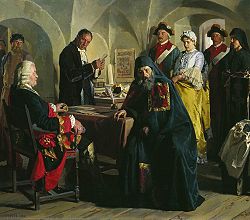 Princess Praskovya Yusupova before becoming a nun Nikolai Nevrev, 1886
Princess Praskovya Yusupova before becoming a nun Nikolai Nevrev, 1886 The Way of Humility: Russian Orthodox nun working at Ein Karem, Jerusalem
The Way of Humility: Russian Orthodox nun working at Ein Karem, Jerusalem
Anglican Communion
Anglican religious orders are organizations of laity and/or clergy in the Anglican Communion who live under a common rule. The term "religious orders" must be distinguished from Holy Orders (the sacrament of ordination which bishops, priests, and deacons receive), though many communities do have ordained members.
The structure and function of religious orders in Anglicanism roughly parallels that which exists in Roman Catholicism. Religious communities are divided into orders proper, in which members take solemn vows and congregations, whose members take simple vows.
Religious communities throughout England were destroyed by King Henry VIII when he separated the Church of England from the papacy during the English Reformation (see Dissolution of the Monasteries). Monasteries were deprived of their lands and possessions, and monastics were forced to either live a secular life or flee the country.
With the rise of the Catholic Revival and the Oxford Movement in Anglicanism in the early 19th century came interest in the revival of "religious life" in England. Between 1841 and 1855, several religious orders for nuns were founded, among them the Community of St. Mary at Wantage and the Community of St. Margaret at East Grinstead.
In the United States and Canada, the founding of Anglican religious orders of nuns began in 1845 with the Sisterhood of the Holy Communion (now defunct) in New York.
In the Episcopal Church in the United States, there are two recognized types of religious communities, called Religious Orders and Christian Communities. The differences are as follows:
A Religious Order of this Church is a society of Christians (in communion with the See of Canterbury) who voluntarily commit themselves for life, or a term of years, to holding their possessions in common or in trust; to a celibate life in community; and obedience to their Rule and Constitution. (Title III, Canon 24, section 1)
A Christian Community of this Church is a society of Christians (in communion with the See of Canterbury) who voluntarily commit themselves for life, or a term of years, in obedience to their Rule and Constitution. (Title III, Canon 24, section 2)
In some Anglican orders, there are sisters who have been ordained and can celebrate the Eucharist.[21]
Fiction and dramatizations featuring
Nuns play an important role in the public's imagination. The following list, of works with Wikipedia articles where nuns play a major part, ranges from A Time for Miracles which is literally hagiography to realistic accounts by Kathryn Hulme and Monica Baldwin to the blatant nunsploitation of Sacred Flesh. All the works use Catholic nuns save Black Narcissus (Anglican). All are outsiders' views with the exceptions of Dead Man Walking, a film based on a non-fiction book of the same title by Helen Prejean, and The Nun's Story, a book by Kathryn Hulme relating the experiences of ex-nun Marie Louise Habets.
See also
- Monk, the male monastic
- Catholic religious order
References
Sources
- Simpson J. A. & Weiner, E. S. C. (1989) The Oxford English Dictionary, Clarendon Press, Oxford
Notes
- ^ The Oxford English Dictionary, vol X, page 599.
- ^ Hellmuth Hecker, [1].
- ^ Mae Chee Kaew - Her Journey to Spiritual Awakening & Enlightenment e-book
- ^ Upasika Kee Nanayon and the Social Dynamic of Theravadin Buddhist Practice
- ^ http://www.buddhistchannel.tv/index.php?id=70,1295,0,0,1,0
- ^ http://www.dhammaweb.net/dhammananda.html
- ^ http://www.thaibhikkhunis.org/eng/index.php?option=com_content&task=blogsection&id=1&Itemid=3
- ^ Charles Brewer Jones, Buddhism in Taiwan: Religion and the State, 1660-1990; University of Hawaii Press, 1999; pp. 154-155
- ^ " Monasteries of nuns which are ordered entirely to contemplative lifealmost always observe papal cloister, that is, cloister according to the norms given by the Apostolic See. Other monasteries of nuns are to observe a cloister adapted to their proper character and defined in the constitutions." Canon 667 §3, CIC 1983
- ^ Canon 648, CIC 1983
- ^ Canon 656, CIC 1983
- ^ Canon 655, CIC 1983
- ^ Canon 657, CIC 1983
- ^ Canon 667 §3, CIC 1983, SCRIS instruction, "Venite seorsum" August 15, 1969, in AAS 61 (1969) 674–690
- ^ a b Arthur Vermeersch, "Religious Life" in The Catholic Encyclopedia.,Vol. 12. New York: Robert Appleton Company, 1911. Accessed 18 July 2011
- ^ "Illud solum votum debere dici solemne . . . quod solemnizatum fuerit per suceptionem S. Ordinis aut per professionem expressam vel tacitam factam alicui de religionibus per Sedem Apostolicam approbatis" (C. unic. de voto, tit. 15, lib. III in 6, quoted in Celestine Anthony Freriks, Religious Congregations in Their External Relations, p. 17).
- ^ Constitution "Conditae a Christo" of 8 December 1900, cited in Mary Nona McGreal, Dominicans at Home in a New Nation, chapter 11
- ^ Cited in Mary Nona McGreal, Dominicans at Home in a New Nation, chapter 11
- ^ Code of Canon Law of 1917, canon 488
- ^ Archpriest Seraphim Slobodskoy, The Law of God (Printshop of St. Job of Pochaev, Jordanville, NY, ISBN 0-88465-004-8), p. 618.
- ^ What We Do sisters of St. Margaret, (Episcopal religious community of women)
External links
- Blogs by Catholic nuns
- Vocation-Network.org information about Catholic religious communities and life as a sister, brother, or priest.
- VocationMatch.com helps those discerning a Catholic religious vocation sort through options and find the order or vocation that may be right for them.
- DigitalVocationGuide.org digital edition of VISION, the annual Catholic religious vocation discernment guide.
- Monastic Matrix: A Scholarly Resource for the Study of Women's Religious Communities 400-1600 C.E.
- Full Text + Illustrations, The Hermits and Anchorites of England by Rotha Mary Clay.
- Nuns of Medieval England, Full Text + Illustrations.
- Religious Orders including Female Religious. Full Text + Illustrations.
- Medieval Shrines of British Saints, including sainted women religious. Full Text + Illustrations.
- Nuns article from The Catholic Encyclopedia
- Instruction on the Contemplative Life and on the Enclosure of Nuns Verbi Sponsa of the Vatican's Congregation for Institutes of Consecrated Life and for Societies of Apostolic Life
- A Biography of a Vajrayana Buddhist Nun
- Martin Luther's letter To Several Nuns, August 6, 1524. (Two reasons life at the convent and vows may be forsaken)
- Sakyadhita — The International Association of Buddhist Women
- The Ursulines Sisters
- The Dominican Monastery of Saint Jude
- Our Lady of the Holy Rosary Monastery in Buffalo NY (A Dominican contemplative monastery with Latin chant)
Categories:- Asceticism
- Nuns
- Religious occupations
Wikimedia Foundation. 2010.

